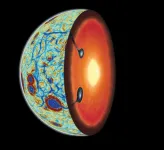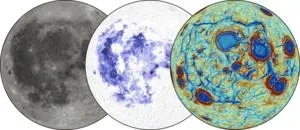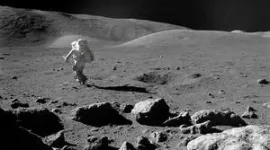(Press-News.org) About 4.5 billion years ago, a small planet smashed into the young Earth, flinging molten rock into space. Slowly, the debris coalesced, cooled and solidified, forming our moon. This scenario of how the Earth's moon came to be is the one largely agreed upon by most scientists. But the details of how exactly that happened are "more of a choose-your-own adventure novel," according to researchers in the University of Arizona Lunar and Planetary Laboratory who published a paper in Nature Geoscience. The findings offer important insights into the evolution of the lunar interior, and potentially for planets such as the Earth or Mars.
Most of what is known about the origin of the moon comes from analyses of rock samples, collected by Apollo astronauts more than 50 years ago, combined with theoretical models. The samples of basaltic lava rocks brought back from the moon showed surprisingly high concentrations of titanium. Later satellite observations found that these titanium-rich volcanic rocks are primarily located on the moon's nearside, but how and why they got there has remained a mystery – until now.
Because the moon formed fast and hot, it was likely covered by a global magma ocean. As the molten rock gradually cooled and solidified, it formed the moon's mantle and the bright crust we see when we look up at a full moon at night. But deeper below the surface, the young moon was wildly out of equilibrium. Models suggest that the last dregs of the magma ocean crystallized into dense minerals including ilmenite, a mineral containing titanium and iron.
"Because these heavy minerals are denser than the mantle underneath, it creates a gravitational instability, and you would expect this layer to sink deeper into the moon's interior," said Weigang Liang, who led the research as part of his doctoral work at LPL.
Somehow, in the millennia that followed, that dense material did sink into the interior, mixed with the mantle, melted and returned to the surface as titanium-rich lava flows that we see on the surface today.
"Our moon literally turned itself inside out," said co-author and LPL associate professor Jeff Andrews-Hanna. "But there has been little physical evidence to shed light on the exact sequence of events during this critical phase of lunar history, and there is a lot of disagreement in the details of what went down – literally."
Did this material sink as it formed a little at a time, or all at once after the moon had fully solidified? Did it sink into the interior globally and then rise up on the near side, or did it migrate to the near side and then sink? Did it sink in one big blob, or several smaller blobs?
"Without evidence, you can pick your favorite model. Each model holds profound implications for the geologic evolution of our moon," said co-lead author Adrien Broquet of the German Aerospace Center in Berlin, who did the work during his time as a postdoctoral research associate at LPL.
In a previous study, led by Nan Zhang at Peking University in Beijing, who is also a co-author on the latest paper, models predicted that the dense layer of titanium-rich material beneath the crust first migrated to the near side of the moon, possibly triggered by a giant impact on the far side, and then sunk into the interior in a network of sheetlike slabs, cascading into the lunar interior almost like waterfalls. But when that material sank, it left behind a small remnant in a geometric pattern of intersecting linear bodies of dense titanium-rich material beneath the crust.
"When we saw those model predictions, it was like a lightbulb went on," said Andrews-Hanna, "because we see the exact same pattern when we look at subtle variations in the moon’s gravity field, revealing a network of dense material lurking below the crust."
In the new study, the authors compared simulations of a sinking ilmenite-rich layer to a set of linear gravity anomalies detected by NASA's GRAIL mission, whose two spacecraft orbited the moon between 2011 and 2012, measuring tiny variations in its gravitational pull. These linear anomalies surround a vast dark region of the lunar near side covered by volcanic flows known as mare (Latin for "sea").
The authors found that the gravity signatures measured by the GRAIL mission are consistent with ilmenite layer simulations, and that the gravity field can be used to map out the distribution of the ilmenite remnants left after the sinking of the majority of the dense layer.
"Our analyses show that the models and data are telling one remarkably consistent story," Liang said. "Ilmenite materials migrated to the near side and sunk into the interior in sheetlike cascades, leaving behind a vestige that causes anomalies in the moon's gravity field, as seen by GRAIL."
The team's observations also constrain the timing of this event: The linear gravity anomalies are interrupted by the largest and oldest impact basins on the near side and therefore must have formed earlier. Based on these cross-cutting relationships, the authors suggest that the ilmenite-rich layer sank prior to 4.22 billion years ago, which is consistent with it contributing to later volcanism seen on the lunar surface.
"Analyzing these variations in the moon's gravity field allowed us to peek under the moon's surface and see what lies beneath," said Broquet, who worked with Liang to show that the anomalies in the moon’s gravitational field match what would be expected for the zones of dense titanium-rich material predicted by computer simulation models of lunar overturn.
Lopsided moon
While the detection of lunar gravity anomalies provides evidence for the sinking of a dense layer in the moon’s interior and allows for a more precise estimate of how and when this event occurred, what we see on the surface of the moon adds even more intrigue to the story, according to the research team.
"The moon is fundamentally lopsided in every respect," Andrews-Hanna said, explaining that the near side facing the Earth, and particularly the dark region known as Oceanus Procellarum region, is lower in elevation, has a thinner crust, is largely covered in lava flows, and has high concentrations of typically rare elements like titanium and thorium. The far side differs in each of these respects. Somehow, the overturn of the lunar mantle is thought to be related to the unique structure and history of the near side Procellarum region. But the details of that overturn have been a matter of considerable debate among scientists.
"Our work connects the dots between the geophysical evidence for the interior structure of the moon and computer models of its evolution," Liang added.
"For the first time we have physical evidence showing us what was happening in the moon’s interior during this critical stage in its evolution, and that's really exciting," Andrews-Hanna said. "It turns out that the moon’s earliest history is written below the surface, and it just took the right combination of models and data to unveil that story."
"The vestiges of early lunar evolution are present below the crust today, which is mesmerizing," Broquet said. "Future missions, such as with a seismic network, would allow a better investigation of the geometry of these structures."
Liang added: "When the Artemis astronauts eventually land on the moon to begin a new era of human exploration, we will have a very different understanding of our neighbor than we did when the Apollo astronauts first set foot on it."
END
How the moon turned itself inside out
University of Arizona scientists combined computer simulations and spacecraft data to solve a long-standing mystery surrounding the moon's "lopsided" geology
2024-04-08
ELSE PRESS RELEASES FROM THIS DATE:
Climate change threatens Antarctic meteorites
2024-04-08
Using artificial intelligence, satellite observations, and climate model projections, a team of researchers from Switzerland and Belgium calculate that for every tenth of a degree of increase in global air temperature, an average of nearly 9,000 meteorites disappear from the surface of the ice sheet. This loss has major implications, as meteorites are unique samples of extraterrestrial bodies that provide insights into the origin of life on Earth and the formation of the Moon.
Disappearing at an alarming rate
By 2050, about a quarter of the estimated of 300,000 - 800,000 meteorites in Antarctica will be lost ...
New study highlights the benefit of touch on mental and physical health
2024-04-08
Through a large-scale analysis, researchers at the Netherlands Institute for Neuroscience have uncovered the ways in which consensual touch can benefit a person’s physical and mental wellbeing.
You might recognize the comforting feeling when someone offers you a hug at the end of a stressful day or strokes your shoulder when you’re feeling down. But the question remains: can touch really help you feel better, and does it matter who it’s from or how they touch you? To explore these questions, researchers from the Social Brain Lab at the Netherlands Institute for Neuroscience and the University Hospital ...
Wyss Institute’s AminoX project receives funding from Northpond Labs to accelerate innovation in protein-based therapeutics
2024-04-08
(BOSTON) — The Wyss Institute for Biologically Inspired Engineering at Harvard University and Northpond Ventures announced today that the VC firm’s affiliate Northpond Labs has signed an agreement to support the development of the AminoX project toward commercialization. This is the fourth Wyss project selected by Northpond Labs for additional funding.
Established in 2020 with the involvement of Harvard’s Office of Technology Development, the five-year strategic research alliance created The Laboratory for Bioengineering Research and Innovation at the Wyss Institute through a $12 million commitment from Northpond Labs to support impactful research ...
How scientists are accelerating chemistry discoveries with automation
2024-04-08
A new automated workflow developed by scientists at Lawrence Berkeley National Laboratory (Berkeley Lab) has the potential to allow researchers to analyze the products of their reaction experiments in real time, a key capability needed for future automated chemical processes.
The developed workflow – which applies statistical analysis to process data from nuclear magnetic resonance (NMR) spectroscopy – could help speed the discovery of new pharmaceutical drugs, and accelerate the development of new chemical reactions.
The Berkeley Lab scientists who developed the groundbreaking technique ...
An inside look at how plants and mycorrhizal fungi cooperate
2024-04-08
For millions of years, underground fungi have lived in symbiosis with plant roots. Plants provide photosynthesized carbon, while fungi deliver water and nutrients. In order to do so, these organisms share space at cellular scale: fungi stretch a network of tendrils called arbuscules into a plant’s root cells, and both organisms rearrange their cells around this structure to facilitate sharing.
Recently, researchers have been able to study both sides of this interaction up close, using RNA sequencing to understand gene expression: one of the first cross-kingdom spatially-resolved transcriptomics studies to date. This paper ...
Do opponents’ race, gender, and party impact US congressional fundraising?
2024-04-08
Donations for a political candidate can be motivated by support for that candidate or by opposition to the candidate’s opponent. New research published in Social Science Quarterly found that female Democrats and non-white male Democrats in the United States have a fundraising advantage when running against a white male Republican. Female Republicans or non-white male Republicans do not have this advantage when running against white male Democrats.
To assess the impact that race, gender, and party ...
Preventive ablation of ventricular tachycardia avoids shocks and hospitalisation
2024-04-08
Berlin, Germany – 8 April 2024: The first randomised trial to investigate preventive ablation of a potential arrhythmogenic substrate associated with coronary chronic total occlusion (CTO) in patients at high risk of ventricular arrhythmias (VAs) reduces the risk of appropriate implantable cardioverter-defibrillator (ICD) therapy and unplanned hospitalisation in patients with no previously recorded VAs. The late-breaking science is presented at EHRA 2024, a scientific congress of the European ...
Cleveland Clinic’s Dr. Matt Kalaycio appointed Chair of Board of Directors for National Comprehensive Cancer Network
2024-04-08
PLYMOUTH MEETING, PA [April 8, 2024] — The National Comprehensive Cancer Network® (NCCN®)—a nonprofit devoted to patient care, research, and education—is announcing the election of Matt Kalaycio, MD, FACP, as Chair of the Board of Directors, with Christopher H. Lieu, MD, elected as Vice-Chair, succeeding Dr. Kalaycio in the position he has held since 2022.
“The exemplary leadership from our board of directors is invaluable as NCCN defines and advances high-quality, high-value, patient-centered cancer care around the world,” said NCCN Chief Executive Officer Crystal S. Denlinger, ...
War in Ukraine is increasing the prevalence of mental health conditions in children, new study finds
2024-04-08
A new study presented at the European Psychiatric Association Congress 2024 reveals a significant rise in mental health issues among children and adolescents displaced by the war in Ukraine. The research, conducted by the Institute of Forensic Psychiatry of MoH of Ukraine, highlights the devastating impact of prolonged exposure to violence and displacement on the mental well-being of young people.
As per UNICEF’s recent report on “The State of the World’s Children 2021”, the current COVID-pandemic ...
Using pulp and paper waste to scrub carbon from emissions
2024-04-08
Researchers at McGill University have come up with an innovative approach to improve the energy efficiency of carbon conversion, using waste material from pulp and paper production. The technique they’ve pioneered using the Canadian Light Source at the University of Saskatchewan not only reduces the energy required to convert carbon into useful products, but also reduces overall waste in the environment.
“We are one of the first groups to combine biomass recycling or utilization with CO2 capture,” said Ali ...
LAST 30 PRESS RELEASES:
Automatic label checking: The missing step in making reliable medical AI
Low daily alcohol intake linked to 50% heightened mouth cancer risk in India
American Meteorological Society announces Rick Spinrad as 2026 President-Elect
Biomass-based carbon capture spotlighted in newly released global climate webinar recording
Illuminating invisible nano pollutants: advanced bioimaging tracks the full journey of emerging nanoscale contaminants in living systems
How does age affect recovery from spinal cord injury?
Novel AI tool offers prognosis for patients with head and neck cancer
Fathers’ microplastic exposure tied to their children’s metabolic problems
Research validates laboratory model for studying high-grade serous ovarian cancer
SIR 2026 delivers transformative breakthroughs in minimally invasive medicine to improve patient care
Stem Cell Reports most downloaded papers of 2025 highlight the breadth and impact of stem cell research
Oxford-led study estimates NHS spends around 3% of its primary and secondary care budget on the health impacts of heat and cold in England
A researcher’s long quest leads to a smart composite breakthrough
Urban wild bees act as “microbial sensors” of city health.
New study finds where you live affects recovery after a hip fracture
Forecasting the impact of fully automated vehicle adoption on US road traffic injuries
Alcohol-related hospitalizations from 2016 to 2022
Semaglutide and hospitalizations in patients with obesity and established cardiovascular disease
Researchers ‘listen in’ to embryo-mother interactions during implantation using a culture system replicating the womb lining
How changing your diet could help save the world
How to make AI truly scalable and reliable for real-time traffic assignment?
Beyond fragmented markets: A new framework for efficient and stable ride-pooling
Can shape priors make road perception more reliable for autonomous driving?
AI tracks nearly 100 years of aging research, revealing key trends and gaps
Innovative techniques enable Italy’s first imaging of individual trapped atoms
KIER successfully develops Korea-made “calibration thermoelectric module” for measuring thermoelectric device performance
Diversifying US Midwest farming for stability and resilience
Emphasizing immigrants’ deservingness shifts attitudes
Japanese eels, climate change, and river temperature
Pusan National University researchers discover faster, smarter heat treatment for lightweight magnesium metals
[Press-News.org] How the moon turned itself inside outUniversity of Arizona scientists combined computer simulations and spacecraft data to solve a long-standing mystery surrounding the moon's "lopsided" geology







